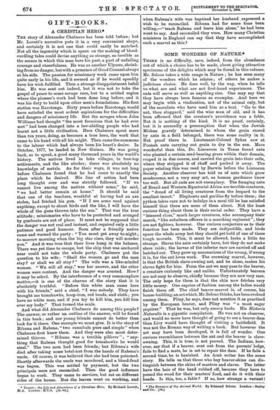THERE is no difficulty, save, indeed, from the abundance out
of which a choice has to be made, about giving attractive specimens of the delights which may be found in this volume. Mr. Selous takes a wide range in Nature ; he has seen many of the wonders which he relates ; of others he makes a judicious choice. He does well, by the way, when he tells us what are and what are not first-hand experiences. The ants will serve as well as anything else. One may say that they have always been famous as examples. And here we may begin with a vindication, not of the animal only, but of the moralists who have used him as a text. "Go to the ant, thou sluggard," said the wise man of old, and it has been affirmed that the creature's providence was a fable. But it is nothing of the kind. It is no proof, certainly, but it is assuredly a presumption that when the Jewish Mishna gravely determined to whom the grain stored by ants in a field belonged, there was some reality in it. But proof there is. Lieutenant-Colonel Sykes saw at Poonah ants carrying out grain to dry in the sun. More wonderful than this, Dr. Lincecum in Texas found ants who planted a certain seed-bearing grass within their domain, reaped it in due course, and carried the grain into their cells, where they stripped it of chaff and packed it away. The • paper relating this was read by Darwin before the Linnaean: Society. Another observer has told us of ants which grow mushrooms, not a very easy art, as human gardeners know too well. But all ants are not exemplary. The foraging ants of Brazil and Western Equatorial Africa are terrible creatures, the "dread of all living creatures from the leopard to the smallest insect." Elephants and gorillas fly before them ; the python takes care not to indulge in a meal till he has satisfied himself that there are none of them about. Not the least curious thing about them is their social order. They have a "leisured class," much larger creatures, who accompany their march, "like subaltern officers in a marching regiment"; they are not fighters, however. One curious conjecture as to their function has been made. They are indigestible, and birds spare the whole army lest they should get bold of one of these tough morsels. This, it must be allowed, looks a little too strange. Slaves the ants certainly have, but they do not make slave raids; the larvae of the inferior race are carried off and hatched out. They grow up unconscious of the wrong, if wrong it is, for the ant loves work. The crowning marvel, however, is that the British slave-owning ant, and he alone, makes his slaves fight for him. From the ant we may pass to the beaver, a creature curiously like and unlike. Unfortunately beavers are not easy to observe, chiefly because they are now very rare. The only hope for them is that the skin now fetches very little money. One caprice of fashion among the ladies would finish them off. The chief beaver-marvel is, of course, his house-building, an art which, Mr. Selous thinks, has been evolved among them. Pliny, he says, does not mention it as practised by the European beaver, and Pliny was "a most eager inquirer." That he was, but only among books. His Historia Naturalis is a gigantic compilation. He was not an observer, and would no more have thought of going to see a beaver-dam than Livy would have thought of visiting a battlefield. It was not the Roman way of writing a book. But however the art may have been developed, it is full of wonder. One curious resemblance between the ant and the beaver is slave. owning. This, it is true, is not proved. The Indians, how- ever, say that if a beaver, sent out from the parents' lodge, fails to find a mate, he is set to repair the dam. If he fails a second time, he is banished. An Arab writer has the same story. He tells us that those who buy beaver-skins can dis- tinguish between the skins of masters and slaves. The latter. have the hair of the head rubbed off, because they have to pound the wood for their masters' food, and do it with their heads. Is this, too, a fable ? If so, how strange a variant!
• The Romance qf the Animal World. By Edmund Selous. London : Seeley aud Co. 1.613 Open the book where we will, we find something astonishing. One more specimen we must give,—it is about the puma, the "friend of man." A certain Maldonada, a girl of Buenos Ayres, was falsely accused of having sought to betray the town to the Indians, and was condemned to be exposed in the forest. An enormous puma guarded her all the night from the attacks of other beasts. The next day she was taken back to the town and pronounced to be innocent. Mr. &Ions satirically suggests that she showed her appreciation of this philanthropic animal by wearing all her life a mantle made of puma-skin.



























































 Previous page
Previous page